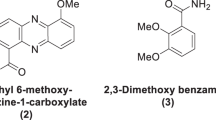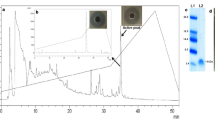Abstract
This study analyzes the in vitro effects of cations and pH on antimicrobial activity of thanatin and s-thanatin against Escherichia coli ATCC25922 and B. subtilis ATCC21332. Thanatin and s-thanatin were synthesized by the solid-phase method using a model 432A synthesizer. The bacterial strains tested included two antibiotic-susceptible strains of Escherichia coli ATCC25922 and B. subtilis ATCC21332. Susceptibility determinations were carried out either in a variety of cation concentrations or in pH conditions from pH 5 to pH 8. NaCl or KCl was added to the media to final concentrations of 0, 10, 50, 100, 200, and 500 mM, whereas CaCl2 and MgCl2 were added to the media to final concentrations of 0, 1, 2, 5, 10, and 20 mM. The antimicrobial activity of thanatin and s-thanatin against Escherichia coli ATCC25922 and B. subtilis ATCC21332 decreased, as indicated by the increasing minimal inhibitory concentrations (MICs) of both peptides with increasing concentrations of Na+/K+/Ca2+/Mg2+. Both peptides lost their activities at 500 mM Na+/K+ but retained them at 20 mM Ca2+/Mg2+. Both peptides have MICs that are not significantly different at a variety of pH levels, with the antimicrobial activity slightly higher in neutral or slightly basic media than under acidic conditions. The antimicrobial peptides thanatin and s-thanatin, which have an anti-parallel β-sheet constrained by disulfide bonds, were salt sensitive against both Gram-positive and Gram-negative pathogens in vitro. Determining the reason why the thanatins are salt sensitive would be useful to provide an understanding of how thanatin and s-thanatin kill bacteria. Futher investigation of the antimicrobial properties of these peptides is warranted.






Similar content being viewed by others
References
Hancock REW, Diamond G (2000) The role of cationic antimicrobial peptides in innate host defences. Trends Microbiol 8:402–410
Wang Z, Wang G (2004) APD: the antimicrobial peptide database. Nucleic Acids Res 32:D590–D592
Zasloff M (2002) Antimicrobial peptides of multicellular organisms. Nature 415:389–395
Yang D, Biragyn A, Hoover DM et al (2002) Mammalian defensins in immunity: more than just microbicidal. Trends Immunol 23:291–296
Fehlbaum P, Bulet P, Chemysh S et al (1996) Structure activity analysis of thanatin, a 21-residue inducible insect defense peptide with sequence homology to frog skin antimicrobial peptides. Proc Natl Acad Sci USA 93:1221–1225
Christensen T (1979) Qualitative test for monitoring coupling completeness in solid phase peptide synthesis using chloranil. Acta Chem Scand Ser B33:763–766
Fields GB, Noble RL (1990) Solid phase peptide synthesis utilizing 9-fluorenylmethoxycarbonyl amino acids. Int J Peptide Protein Res 35:161–162
National Committee for Clinical Laboratory Standards (2003) Methods for dilution antimicrobial susceptibility tests for bacteria that grow aerobically. 6th edn. Approved Standard M7-A6. NCCLS, Wayne, PA
Senthil KK, Ronald GL (2006) Effect of salt on the interactions of antimicrobial peptides with zwitterionic lipid bilayers. Biochim Biophys Acta 1758:1274–1284
Tomita T, Hitomi S, Nagase T et al (2000) Effect of ions on antibacterial activity of human beta defensin 2. Microbiol Immunol 44:749–754
Hoover DM, Wu Z, Tucker K et al (2003) Antimicrobial characterization of human beta-defensin 3 derivatives. Antimicrob Agents Chemother 47:2804–2809
Bellamy W, Takase M, Wakabayashi H et al (1992) Antibacterial spectrum of lactoferricin B, a potent bactericidal peptide derived from the N-terminal region of bovine lactoferrin. J Appl Bacteriol 73:472–479
Helmerhorst EJ, Breeuwer P, van’t Hof W et al (1999) The cellular target of histatin 5 on Candida albicans is the energized mitochondrion. J Biol Chem 274:7286–7291
Cox DL, Sun Y, Liu H et al (2003) Susceptibility of Treponema pallidum to host-derived antimicrobial peptides. Peptides 24:1741–1746
Miyasaki KT, Iofel R, Oren A et al (1998) Killing of Fusobacterium nucleatum, Porphyromonas gingivalis and Prevotella intermedia by protegrins. J Periodontal Res 33:91–98
Cole AM, Darouiche RO, Legarda D et al (2000) Characterization of a fish antimicrobial peptide: gene expression, subcellular localization, and spectrum of activity. Antimicrob Agents Chemother 44:2039–2045
Wu M, Maier E, Benz R, Hancock RE (1999) Mechanism of interaction of different classes of cationic antimicrobial peptides with planar bilayers and with the cytoplasmic membrane of Escherichia coli. Biochemistry 38:7235–7242
Lee IH, Cho Y, Lehrer RI (1997) Effects of pH and salinity on the antimicrobial properties of clavanins. Infect Immun 65:2898–2903
Minahk CJ, Morero RD (2003) Inhibition of enterocin CRL35 antibiotic activity by mono- and divalent ions. Lett Appl Microbiol 37:374–337
Author information
Authors and Affiliations
Corresponding author
Additional information
G. Wu and J. Ding contributed equally to this article.
Rights and permissions
About this article
Cite this article
Wu, G., Ding, J., Li, H. et al. Effects of Cations and PH on Antimicrobial Activity of Thanatin and s-Thanatin Against Escherichia coli ATCC25922 and B. subtilis ATCC 21332. Curr Microbiol 57, 552–557 (2008). https://doi.org/10.1007/s00284-008-9241-6
Received:
Revised:
Accepted:
Published:
Issue Date:
DOI: https://doi.org/10.1007/s00284-008-9241-6




